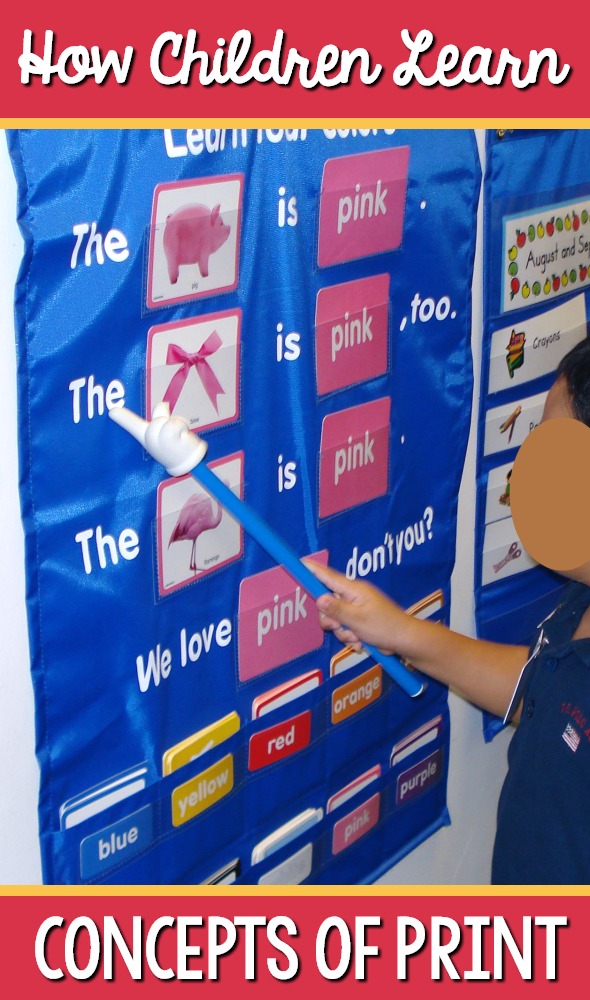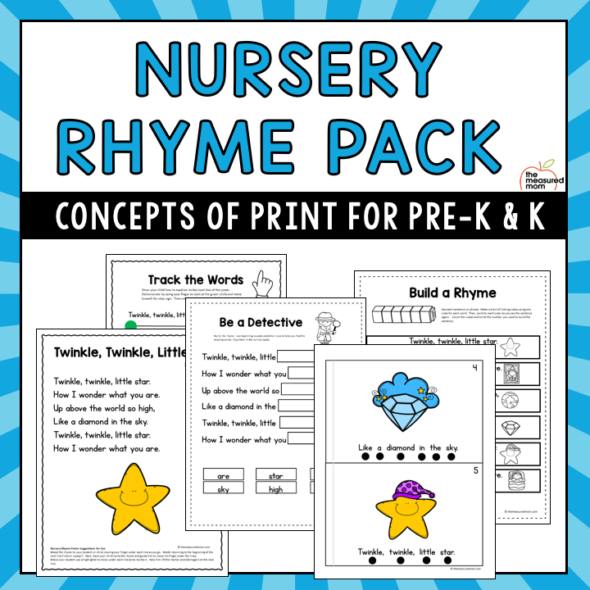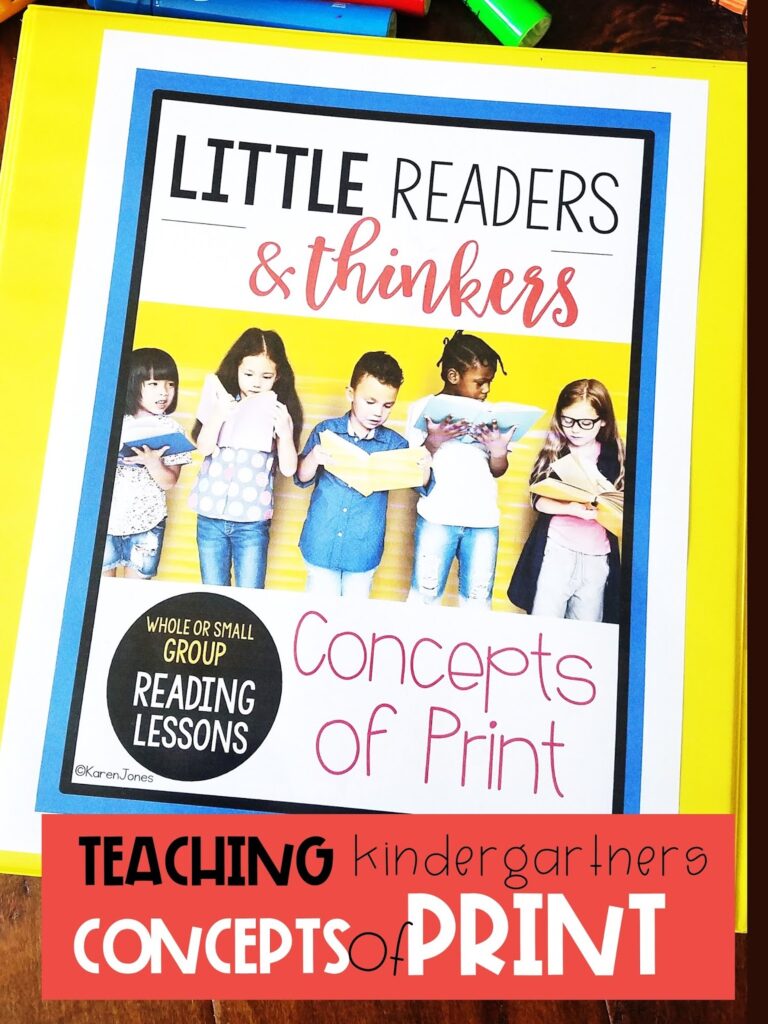Concepts of Print Choose a Level C-F book for the administration of this assessment. It should have distinct layout of print and illustrations, good spacing of words and multiple lines of text. Begin by telling the child, “I‟m going to read you this story and I want you to help me. It is called.” 1. Concepts of print are a great predictor in a child’s future success as a reader. Concepts of print influence a child’s fluency and accuracy as a reader later in life. Instructors will assume that all children know the concepts of print when the student enters the classroom, but that is not always true. This assessment is based on the research on concepts of print by Marie Clay. It is a formative assessment that evaluates kindergarten children’s level of understanding of print and its concepts. I like the fact that the assessment is provided along with the implications for instruction of print, a scoring guide for the test and the benchmark. Concepts of print are basic understandings about how written language and books “work.” These understandings include: That written words convey a message; How books and print are oriented and the components they include; The differences between units of print (letters, words, and sentences) Concepts of print are instinctive to proficient.
Some of the links in this post are affiliate links. This means if you click on the link and purchase the item, I will receive a small commission at no extra cost to you. All opinions remain my own.
Chances are, you are either a parent or early childhood educator trying to understand more about concepts of print. If so, you’ve come to the right place!
Let’s take a look at what concepts of print are, tips for teaching the skills, and how to assess.
What is Concepts of Print
When teachers refer to concepts of print, they are referencing how text works, or a kids’ ability to understand print, text, or written language.
Concepts of Print includes:
- Identifying front and back of the book
- Finding the title
- Knowing what an author and illustrator are
- Knowing where the words are
- Understanding the different symbols (numbers vs. letters)
- Where to start reading and writing
- Following print from left-to-right
- Swooping down after getting to the end of a line
- Pointing and reading one-to-one (pointing to one word as one word is spoken)
- The first and last word on each page
- Knowing how to tell the start and end of a sentence.
- Turning pages from right to left
- Understanding a space separates words
- Identifying the first and last letter of a word
- Knowing the purpose of capital letters and punctuation

Tips for Teaching Concepts of Print
As an essential foundation of reading, it’s important for parents and teachers to help the kids develop these early reading and writing skills.
Here are some ways you can help kids with concepts of print:
- Do a read-aloud every day: As you read, the kids begin to develop a sense of language to text relationship, meaning the spoken words come from the print with the book.
- Shared reading activities: While reading aloud a book, encourage the kids to participate in predictions, highlighting text features, having picture talks, etc. The goal is for the kids to interact with the text.
- Read or sing a Poem of the Day:Point to the words as the kids recite the familiar poems and nursery rhymes. If you give them their own printable poem, they can point to the words and follow along.
Use poems to practice finding sight words within text.
- Expose the kids to various types and sizes of books: board books, magazines, big books, touch and feel books, flap books, picture books, and even books on their favorite tablets.
- Build a print rich environment (at home and in the classroom): label everything, set up a reading corner, and hang fun alphabet posters, anchor charts, poetry posters and Build-a-Poem word cards, and word walls.
- Reference environmental print often: Point out letters and words on their favorite cereal or snack boxes, read aloud street signs, familiar restaurant signs, toy packaging, etc.
- Model fluency and expression often: Express the importance of stopping when you get to a period, pausing when you see a comma, changing your tone of voice when reading questions, etc.
- Highlight text features: Let the kids use highlighters, highlighting tape, crayons, or their favorite gel pens to highlight or circle text features such as capital letters, punctuation, first/last word, first letter of each word, etc. When doing this, be sure to pick one feature to focus on at a time.
When highlighting text, I prefer to use printable poems or printable books for kids, as shown in the picture below.
- Record a Morning Message or Daily News: Write a morning message or daily news on large chart paper. Let the kids verbally share their ideas to add to the message, and you write them down word for word. For example, “Good morning! Today is Monday. We will read a book, and practice the letter Mm.” Then, ask the kids “what starts with M?”. When they tell you mouse starts with M, write down “Mouse starts with M.” Then add a few more. The whole point is for them to see you write their spoken words.
- Practice Making Words and Building Sentences: You can use printable making words or building sentences worksheets with letter and word tiles, or purchase a magnetic letter set, to practicing building words and sentences.
These Making Words cut and paste worksheets are great practice for concepts of print.
- Do letter and number sorts: Give the kids a mixed up set of letters and numbers, and have them sort them into two groups. This will demonstrate their ability to distinguish letters from numbers, which is an important concepts of print skill. To incorporate play-based learning into teaching concepts of print, you could fill a sensory bin with letters and numbers, and let them do a sort while “playing”.
My friend, Amanda, is a mom of 2 and an amazing teacher. She created the Ultimate Sensory Box.
Use the code: LITTLELEARNINGCORNER to get 10% off your first box!

- Name building activities: The first word most kids learn to read is their name. This is the perfect opportunity to use their interest (themselves), and build on concepts of print, such as pointing out the first letter and last letter of their names. You could also have the kids use letter tiles to build their name, and count how many letters are in their name. When done, make a room display sharing all of the fun name building work they’ve done.
Here’s a video we made to share some name building activities with you all.
- Use pointers to track print: Use a fun pointer, or make your own out of popcicle sticks and foam stickers, to practice tracking print from left to right, top to bottom, while reading.
- Do Book Walks or Picture Walks: To practice turning pages from right to left, and distinguishing text from pictures, do book walks often. Book walks, or picture walks, are when you have the kids walk through the book, starting at the first page, and tell what they see happening in the pictures. Once you’ve gone through all of the pages, encouraging kids to participate in talking about the pictures, they will have already formed an understanding of what the book is about. Then, when reading the text, they will understand the printed words help explain what is happening throughout the book.
- Do Letter Hunts: When doing a letter hunt, on a worksheet or in a book, the kids track print from left to right, top to bottom, searching for specific letters. Grab these printable Letter Hunt worksheets to begin practicing concepts of print, today!
- Who has front cover/back cover?: Have the kids put their hands in their laps, then put a book in front of each of them (mixing up who has a front cover or back cover facing up). Tell them not to touch the book until you say “go”. They look to see if they have a front cover facing up or a back cover. Tell them, “if you see the front cover of your book, hold it up. Go”. After they put theirs down, call out the same for the back covers. Keep the game going by letting the kids pass a book to their friend (face up of face down).
- Follow along on audio: Let the kids follow along to their favorite stories on audio. I absolutely love audiobooks on Audible. If you don’t already have it installed, you can try it and get 2 free audiobooks, here.
- Build alphabet awareness: The more you build on alphabet, letter-to-sound correspondence, the more the kids will begin to understand concepts of print.
- Authors and Illustrators for a day: This is such a fun activity to practice concepts of print. The kids will pair up to be an author and illustrator for a day. One kid gets to tell the story (either they try to write it, or an adult writes the child’s exact words), and the other kid gets to draw pictures to match the story. In the end, they will have a book they can present to their friends and family.

- Encourage journal writing: The best way for kids to practice concepts of print is to apply their skills to writing. Encourage early writing skills to get the kids comfortable with sharing their thoughts on paper. Even if they are still emerging writers, their written work needs to be validated, too. When ready, encourage them to begin writing letters for the sounds they hear in a word. Pretty soon, they will be writing the beginning sounds for each word, leaving spaces, and punctuation will start to appear. All of these are signs of understanding concepts of print. They can also draw pictures to represent their words.
Concepts of Print Assessment

When your kiddos pick up a book, take note of their directionality. Do they know how to hold the book? Can they point to the front cover and the title? These simple observations are the first part of doing a concepts of print assessment.
Once they identify the front/back covers, see if they can point to the first and last words on the page.
As a kindergarten teacher, I encouraged journal writing everyday. The kids’ journals were my way of assessing concepts of print.
Let’s look at an example of an end-of-the-year kindergarten writing sample:
Based on the kindergarten writing sample above, we can tell this kid has the following concepts of print skills:
- writes from left to right
- writes from top to bottom
- has correct letter formation except one letter reversal
- uses punctuation at the end of her sentence
- leaves spaces in between her words
- draws an illustration to match her writing
The following is a printable Concepts of Print assessment, I used to document the kid’s writing progress:
Check out the reviews on this Concepts of Print rubric, HERE.
Concepts Of Print - Class Playground
These rubrics are a great way to document the child’s progress, as well as share the information with the parents. They, too, like to know what their child is expected to learn as an emergent reader and writer.
Concepts Of Print Video
Conclusion
Thank you so much for stopping by to learn more about concepts of print. I hope you found this blog post useful, and are able to get started teaching and assessing concepts of print.
Concepts Of Print Anchor Chart
Before you go, here are a few blog posts you may enjoy:
Concepts Of Print Assessment
Concepts of Print
